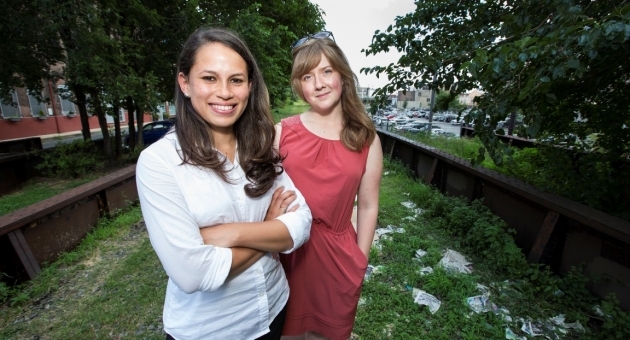Temple Ambler alumni reimagine Philly's abandoned Reading Railroad

The Reading Railroad was once one of the primary industrial lifelines for the City of Philadelphia. But its use came to an end in 1984, leaving behind a mostly unused swath of gravel, greenery and tunnels.
The railway's three-mile stretch spans 55 city blocks and five neighborhoods and includes the elevated Reading Viaduct, vast underground sections with 30-foot high vaulted ceilings and uncapped below ground sections that have become ecosystems unto themselves.
For students completing a senior studio design project in Temple University’s Department of Landscape Architecture and Horticulture, this “forgotten” site presented a rich canvas for innovative ideas designed to revitalize the region and enrich the neighborhoods through which the railroad once traveled.
After graduation, landscape architecture alumni Diana Fernandez, SED'12, and Amy Syverson, SED'12, used the work produced in their senior project as a jumping off point to a larger collaboration. Their efforts have contributed to a groundswell of grassroots and governmental interest in the Reading Railroad site.
On Nov. 18, Fernandez and Syverson, along with project partner Susan Kolber of the University of Pennsylvania, will be presented with a Student Award of Excellence from the American Society of Landscape Architects for Above, Below, Beyond, an exhibition that showcased ways to reimagine the abandoned space.
“This is an exciting role for landscape architects to play in the future; you don’t always have to build something to make a difference," said Amy Syverson, who, along with Fernandez, is a landscape designer at Wells Appel in Philadelphia. "By thinking and talking and providing inspiration, you can be part of the solution.”
The award caps off a whirlwind year that took the pair's work from the classroom to a Kickstarter-funded exhibit to potential implementation in the future.
Once Fernandez and Syverson completed their senior project, they simply couldn’t let go of the idea that the Reading Railroad space — with its elevated sections, tunnels that run under Pennsylvania Avenue and Fairmount Park and open up to the Rodin Museum and vegetated spaces that bustle with life — could become something of great value to the communities that surround it and the city as a whole.
“The tunnels are almost cathedral-like and the uncapped areas are some of the coolest locations I’ve ever seen — there is this blend of nature and the sound of birds and people and the streetscape above, " Fernandez said. “
"In the classroom, we came up with ideas that ranged from a transit hub to an extension of the Philadelphia Art Museum to a research center for the Franklin Institute; when we graduated, we wanted to take it beyond that — we wanted to get community buy-in,” she said.
Working closely with Kolber, who had also studied the railway in classes at the University of Pennsylvania, Syverson and Fernandez set about developing a public exhibition at Girard and 26th Avenue in cooperation with Next City’s Storefront for Urban Innovation program to present plans for the Reading Railroad to the community. They turned to crowdsourcing to fund the exhibit, running a Kickstarter campaign that raised nearly $6,200.
That success took them by surprise. "None if this would have been possible without our supporters, our student colleagues, our professors, grassroots groups like VIADUCTGreene and Friends of the Rail Park. There’s truly been this groundswell of support,” said Fernandez
A significant part of the exhibit, Syverson said, was giving community members a voice in the process. Visitors to the exhibit were asked to provide their own ideas for uses of the various Reading Railroad spaces — above ground and below. Hundreds of postcards were submitted with ideas ranging from an underground jazz club to zip line parks and passive gardens.
“Visitors brought that same kind of innovation to their ideas — one person suggested creating an art installation piece consisting of a forest of pink foam spikes!" said Syverson. "It was about inviting people to imagine what the space might be, about looking at the city in a different way."
Groups like Friends of the Rail Park, VIADUCTGreene, and the Reading Viaduct Project are taking everything the trio has done so far and continuing the discussion. The Philadelphia Planning Commission has included the Reading Railroad site in the Central District Plan within the 2035 master plan as potential city park and transit space.
“It’s great to see that while this might be the end of this part of the project, it’s really just the beginning. I can’t wait to see where it all goes from here,” Fernandez said.